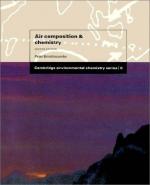|
This section contains 621 words (approx. 3 pages at 300 words per page) |

|
Many kinds of particulates and gases are deposited from the atmosphere to the surfaces of terrestrial and aquatic ecosystems. Wet deposition refers to deposition occurring while it is raining or snowing, whereas dry deposition occurs in the time intervals between precipitation events.
Relatively large particles suspended in the atmosphere, such as dust entrained by strong winds blowing over fields or emitted from industrial smokestacks, may settle gravitationally to nearby surfaces at ground level. Particulates smaller than about 0.5 microns in diameter, however, do not settle in this manner because they behave aerodynamically like gases. Nevertheless, they may be impaction-filtered from the atmosphere when an air mass passes through a physically complex structure. For example, the large mass of foliage of a mature conifer forest provides an extremely dense and complex surface. As such, a conifer canopy is relatively effective at removing particulates of all sizes from the...
|
This section contains 621 words (approx. 3 pages at 300 words per page) |

|


